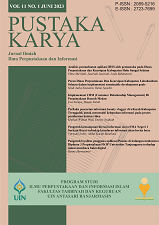Lanskap terapeutik pada perpustakaan: redefinisi peran perpustakaan pascapandemi covid-19
DOI:
https://doi.org/10.18592/pk.v12i1.12410Keywords:
kesehatan mental, lanskap terapeutik, perpustakaanAbstract
Gagasan lanskap terapeutik telah digunakan secara luas untuk menggambarkan hubungan antara tempat dan peningkatan kesehatan mental. Tulisan ini menggunakan data dari penelitian kualitatif yang dilakukan dengan pemustaka dengan latar belakang yang beragam untuk menguraikan peran perpustakaan umum sebagai lanskap terapeutik. Data dikumpulkan dengan metode purposive dan convenience sampling dengan mewawancara dua orang pustakawan dan sepuluh pengunjung Perpustakaan Umum Daerah DKI Jakarta. Data yang didapat kemudian dianalisis menggunakan 3 tahapan yaitu pengumpulan dan reduksi data, interpretasi data, dan penulisan atau penyusunan laporan penelitian. Tulisan ini menempatkan perpustakaan umum sebagai ruang yang secara bersamaan akrab dan ramah, nyaman dan menenangkan, serta memberdayakan. Lebih lanjut, tulisan ini difokuskan untuk menggambarkan konsep lanskap terapeutik yang diterapkan pada perpustakaan umum dan bagaimana pemustaka mempersepsikan lanskap terapeutik yang diterapkan pada perpustakaan.References
Aarts, H and Dijksterhuis, AP. (2003). The Silence of the Library: Environment, Situational Norm, and Social Behavior. Journal of Personality and Social Psychology. Vol 4 (1): 18-24
Association of Research Libraries Statistics and Assessment Program. (2014). LibQUAL+®. Retrieved September 12, 2014, from https://www.libqual.org/about/about_lq/general_info
Black. A. (2011). ‘We don’t do public libraries like we used to’: Attitudes to public library buildings in the UK at the start of the 21st century. J. Librariansh. Inf. Sci., 43(1), 30-45.
Brewster, Liz. (2014). The Public Library as Therapeutic Landscape: A Qualitative Case Study. Health & Place 26: 94-99
Charmaz,K.(2006).Constructinggroundedheory:Apracticalguidethroughqualitativeanalysis.SagePublication.
Curry, A., Alstad, C., (2003). Public space, public discourse, and public libraries. Libres13,1.
Duff, C. (2012). Exploring the role of “enabling places” in promoting recovery frommental illness: a qualitative test of a relational model. Health and Place, 18(6),1388–1395.
Gesler,W.M.(1993).TherapeuticLandscapes:Theoryandacasestudyof Epidaurus. Greece’ Environment andPlanning D.
Gesler,W.M.(1998),‘Bath’sreputationasahealingplace’,inR.A.KearnsandW.M.Gesler(eds)puttinghealthinto place. SyracuseUniversityPress
Hernon, P. & Nitecki, D. (2001). Service quality: A concept not fully explored. Library Trends 49, 687- 708.
Husaini H., Noordin, S.A and Shuhidan S.M (2015). Bibliotherapy in the Malaysian Public Libraries: A Conceptual Framework’. The Asian Conference on Literature and Librarianship 2015. Osaka 2 – 5 April. Conference Proceedings; ISSN 2186-2281
Husaini H., Noordin, S.A and Shuhidan S.M (2015). Assessing The Public Library Therapeutic Landscape Quality and Satisfaction: A Conceptual Framework. International Journal of Computer Science and Electronic Engineering. 3 (5): 371 – 374.
Husaini H., Noordin, S.A and Shuhidan S.M (2015). The Public Library as Therapeutic Landscape: Quality and Satisfaction. National Invention Innovation Design Research. Faculty of Information Management, MARA University of Technology, ISBN: 9789834277161
Hassan, Z.A., Schattner, P. and Mazza, D. (2006). Doing pilot study: why is it essential? Malaysian Family Physician, 1 (2&3), 70-73.
Jiang, Shan. (2014). “Therapeutic Landscapes and Healing Gardens: A Review of Chinese Literature in the Relation to the Studies in Western Countries.” Frontiers of Architectural Research 3 (2): 141- 53.
Kearns, R.A. and Barnett, J.R. (1999) Auckland's Starship Enterprise: Placing Metaphor in a Children's Hospital. Therapeutic Landscapes: The Dynamic Between Place and Wellness. MD: University Press of America, Inc.: 169-99.
Kearns, R.A. and Collins,. (2000) D.C. New Zealand children's health camps: Therapeutic landscapes meet the contract state. Social Science & Medicine. 5l(7):2000, 1047-59.
Korpela, K.M., Ylen M. (2007). Perceived health is associated with visiting natural favorite places in the vicinity. Health Places 13 (1): 138-151
Parasuraman, A. A., Zeithaml, V. A., & Berry, L. L. (1988). SERVQUAL : A multiple-item scale formeasuringconsumer perceptionsofservice quality.JournalOfRetailing,64(1).
Puspitasari, D. (2020). Implementasi therapeutic landscape dalam perpustakan. Jurnal Perpustakaan Universitas Erlangga, 10(1), 50-56. https://e-journal.unair.ac.id/RLJ/article/download/10252/6223
Saldana, J. (2009). The coding manual qualitative researchers. Sage Publication.
Toyne,J.,Usherwood,B.(2001).Checkingthebooks:Thevalueandimpactofreportof research funded by the Arts and Humanities Research Board. Centre for thePublic Library and Information in Society, Department of Information Studies,TheUniversityofSheffield.
Williams,A.(2002).Changinggeographiesofcare:employingtheconceptoftherapeuticlandscapes as a framework in examining home space. Social Science & Medicine, 55(1),141-54.
Wilson, K. (2003). Therapeutic Landscapes and First Nations peoples: an exploration of culture, health and place. Health & Place.9(2): 83-93.
Winterson, J., (2012). We Must Protect and Reinvent Our Local Libraries. The Guardian, London, 23 November.
Wood, V.J., et al., (2013). Creating “therapeutic landscapes” for mental health careers in inpatient settings: a dynamic perspective on permeability and inclusivity. Soc. Sci. Med. 91, 122–129
Yates, I., Holmes, G., Priest, H.(2012). Recovery, place and community mental healthservices.Journal of MentalHealth,21(2),104-13.
Zakaria, Z.; Z.H. Hussin; N. Noordin; M.Z.H.M. Sawal; S.M.A.S. Ahmad Alhady, et al., (2011). Service Quality Dimensions In Public Library: Northern Area Experienced”, J. Soc. Sci., 7: 265-270
Downloads
Published
How to Cite
Issue
Section
License
Copyright (c) 2024 Yokke Andini, Najmi Fuady

This work is licensed under a Creative Commons Attribution 4.0 International License.
Copyright (c) Author (s)

Pustaka Karya: Jurnal Ilmiah Ilmu Perpustakaan dan Informasi is licensed under a Creative Commons Attribution 4.0 International License.
- Articles published in Pustaka Karya are licensed under a Creative Commons Attribution 4.0 International License. You are free to copy, transform, or redistribute articles for any lawful purpose in any medium, provided you give appropriate credit to the original author(s) and Pustaka Karya.
- Copyright on articles is retained by the respective author(s), without restrictions. A non-exclusive license is granted to Pustaka Karya to publish the article and identify itself as its original publisher, along with the commercial right to include the article in a hardcopy issue for sale to libraries and individuals.
- By publishing in Pustaka Karya, authors grant any third party the right to use their article to the extent provided by the Creative Commons Attribution 4.0 International license.









1.png)
1.png)

